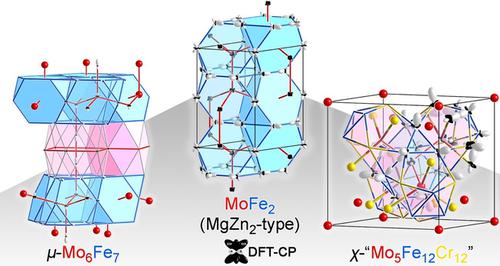当前位置:
X-MOL 学术
›
Z. Anorg. Allg. Chem.
›
论文详情
Our official English website, www.x-mol.net, welcomes your
feedback! (Note: you will need to create a separate account there.)
Structural Plasticity in the Frank‐Kasper Realm: Chemical Pressure Roles of the μ‐ and χ‐Phase Units in the Mo−Fe−Cr System
Zeitschrift für anorganische und allgemeine Chemie ( IF 1.1 ) Pub Date : 2020-12-23 , DOI: 10.1002/zaac.202000340 Katerina P. Hilleke 1 , Kendall R. Kamp 1 , Yueai Lin 1 , Daniel C. Fredrickson 1
Zeitschrift für anorganische und allgemeine Chemie ( IF 1.1 ) Pub Date : 2020-12-23 , DOI: 10.1002/zaac.202000340 Katerina P. Hilleke 1 , Kendall R. Kamp 1 , Yueai Lin 1 , Daniel C. Fredrickson 1
Affiliation

|
Intermetallic phases have been known to exhibit a wide diversity since Pauling's seminal investigations into NaCd2 in the 1920s that, along with Cd3Cu4 and Mg2Al3, was shown by Samson to crystallize with a giant cubic cell containing >1000 atoms. The concept of structural plasticity – the notion that complex structures emerge from the release of internal stresses that would arise in simpler structures – has recently been used to account for one family of intermetallics, tracing the structures of Ca2Ag7, Ca14Cd51, CaPd5, and CaCd6 to chemical pressure (CP) issues in the CaCu5 type. Here, we extend the ideal of structural plasticity closer to the giant cells elucidated by Pauling and Samson through its application to a series of Mo−Fe−Cr Frank‐Kasper phases. We begin with a DFT‐CP analysis of the MgZn2‐type phase MoFe2, which serves as a parent structure to μ‐Mo6Fe7 and χ‐Mo5Cr6Fe18. The analysis reveals negative CPs around the Mo atoms arising from collisions between the Fe atoms. Tighter Mo coordination is provided in the μ‐ or χ‐phases by substituting some of the Friauf polyhedra of MoFe2 with either μ‐ and χ‐phase units, resulting in layers or blocks of Laves‐like connectivity. Sites preferences in the μ‐phase and the role of Cr substitution in the χ‐phase are explained through the dual lenses of CP and electronegativity. Parallels to the features of NaCd2 hint that such giant‐unit‐celled intermetallics can represent striking manifestations of structural plasticity.
中文翻译:

Frank-Kasper领域中的结构可塑性:Mo-Fe-Cr系统中μ和χ相单元的化学压力作用
自从Pauling在1920年代对NaCd 2进行开创性研究以来,金属间相表现出了广泛的多样性,Samson证明了金属间相与Cd 3 Cu 4和Mg 2 Al 3一起结晶,并与一个包含> 1000个原子的巨型立方晶胞一起结晶。结构可塑性的概念-复杂结构是由于释放内部应力而产生的,而内部应力的释放会在较简单的结构中出现-最近已用于解释一族金属间化合物,追踪的是Ca 2 Ag 7,Ca 14 Cd 51,CaPd 5和CaCd 6CaCu 5型的化学压力(CP)问题。在这里,我们通过将其应用于一系列Mo-Fe-Cr Frank-Kasper相,使Pauling和Samson阐明的结构可塑性理想更接近巨型细胞。我们开始与的MgZn的DFT-CP分析2型相钼铁2,其作为母体结构到μ-沫6的Fe 7和χ -Mo 5的Cr 6铁18。分析揭示了由于Fe原子之间的碰撞而在Mo原子周围产生的负CP。在μ或χ中提供更紧密的Mo配位通过用μ和χ相单元替换MoFe 2的某些Friauf多面体,形成Laves型连通性的层或块。在网站偏好μ -PHASE和Cr取代在作用χ -PHASE通过CP和电负性的双重透镜说明。与NaCd 2的特征平行表明,这种巨大的单元孔金属间化合物可以代表结构可塑性的显着表现。
更新日期:2021-02-05
中文翻译:

Frank-Kasper领域中的结构可塑性:Mo-Fe-Cr系统中μ和χ相单元的化学压力作用
自从Pauling在1920年代对NaCd 2进行开创性研究以来,金属间相表现出了广泛的多样性,Samson证明了金属间相与Cd 3 Cu 4和Mg 2 Al 3一起结晶,并与一个包含> 1000个原子的巨型立方晶胞一起结晶。结构可塑性的概念-复杂结构是由于释放内部应力而产生的,而内部应力的释放会在较简单的结构中出现-最近已用于解释一族金属间化合物,追踪的是Ca 2 Ag 7,Ca 14 Cd 51,CaPd 5和CaCd 6CaCu 5型的化学压力(CP)问题。在这里,我们通过将其应用于一系列Mo-Fe-Cr Frank-Kasper相,使Pauling和Samson阐明的结构可塑性理想更接近巨型细胞。我们开始与的MgZn的DFT-CP分析2型相钼铁2,其作为母体结构到μ-沫6的Fe 7和χ -Mo 5的Cr 6铁18。分析揭示了由于Fe原子之间的碰撞而在Mo原子周围产生的负CP。在μ或χ中提供更紧密的Mo配位通过用μ和χ相单元替换MoFe 2的某些Friauf多面体,形成Laves型连通性的层或块。在网站偏好μ -PHASE和Cr取代在作用χ -PHASE通过CP和电负性的双重透镜说明。与NaCd 2的特征平行表明,这种巨大的单元孔金属间化合物可以代表结构可塑性的显着表现。











































 京公网安备 11010802027423号
京公网安备 11010802027423号